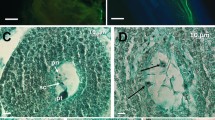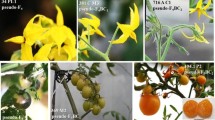Abstract
The goal of this research was to study the introgression of the high regeneration capacity of Lycopersicon pimpinellifolium Mill line WV-700, in recalcitrant tomato cultivars (L. esculentum Mill cvs. Petomech, Santa Rita and VFN-8) using backcrossing. Hypocotyl explants of in vitro germinated seeds were cultivated in half strength MS medium supplemented with 5mg/l 6-BA to assess their shoot regeneration capacity. The apical shoot of the in vitro germinated seeds were cultured on a separate medium. Apical shoots from genotypes showing high regeneration rates were acclimated in a glasshouse and used as pollen donors for the next backcrossing. After four backcrossings, the material showed a similar mean fruit weight for the cultivated tomato and a high regeneration capacity similar to the wild species. It is shown that L. pimpinellifolium can be used with success as donor parent to introgress in vitro regeneration capacity to recalcitrant tomato cultivars.
Similar content being viewed by others
References
BenAmer, I.M., V. Korzum, A.J. Worland & A. Borner, 1997. Genetic mapping of QTL controlling tissue culture response on chromosome 2B of wheat (Triticum aestivum L.) in relation to major genes and RFLP markers. Theor Appl Genet 94: 1047–1052.
Faria, R.T. & R.D. Illg, 1996. Inheritance of in vitro plant regeneration ability in the tomato. Genet Mol Biol (Rev Bras Genet) 19: 113–116.
Henry, Y., P. Vain & J. De Buyser, 1994. Genetic analysis of in vitro plant tissue culture responses and regeneration capacities. Euphytica 79: 45–58.
Koornneef, M., J. Bade, C. Hanhart, K. Horsman, J. Schel, W. Soppe, R. Vekerk & P. Zabel, 1993. Characterization and mapping of a gene controlling shoot regeneration in tomato. Plant J 3: 131–141.
Koornneef, M., C.J. Hanhart & L. Martinelli, 1987. A genetic analysis of cell culture traits in tomato. Theor Appl Genet 74: 633–641.
Koornneef, M., M. Jongsma, I. Toma, R. Weide, P. Zabel & J. Hille, 1986. Breeding of a tomato genotype readily accessible to genetic manipulation. Plant Sci 45: 201–208.
Lipucci Di Paolo, M., F. Collina Grenci & A. Scala, 1983. Shoot forming ability of Lycopersicon esculentum Mill. varieties by in vitro cultured cotyledons. Acta Hort 131: 111–116.
Miller, J.C. & S.D. Tanksley, 1990. RFLP analysis of phylogenetic relationships and genetic variation in the genus Lycopersicon. Theor Appl Genet 80: 437–448.
Murashige, T. & F. Skoog, 1962. A revised medium for rapid growth and bioassays with tabacco tissue cultures. Physiol Plant 15: 473–497.
Plastira, V.A. & A. Perdikaris, 1997. Effect of genotype and explant type in regeneration frequency of tomato in vitro. Acta Hort 447: 231–234.
Rick, C.M., 1982. The potencial of exotic germplasm for tomato improvement. In: I.K. Vasil, W.R. Scowcroft & K.J. Frey (Eds.), Plant Improvement and Somatic Cell Genetics, pp. 1–28. Academic Press, New York.
Taguchi-Shiobara, F., S.Y. Lin, K. Tanno, T. Komatsuda, M. Yano, T. Sasaki & S. Oka, 1997. Mapping quantitative trait loci associated with regeneration ability of seed callus in rice, Oryza sativa L. Theor Appl Genet 95: 828–833.
Takashina, T., T. Suzuki, H. Egashira & S. Imanishi, 1998. New molecular markers linked with the high regeneration shoot regeneration capacity of the wild tomato species Lycopersicon chilense. Breed Sci 48: 109-113.
Wijbrandi, J., J.G.M. Vos & M. Koornneef, 1988. Transfer of regeneration capacity from Lycopersicon peruvianum to L. esculentum by protoplast fusion. Plant Cell Tiss Org Cult 12: 193–196.
Author information
Authors and Affiliations
Rights and permissions
About this article
Cite this article
Tadeu de Faria, R., Destro, D., Filho, J.C.B. et al. Introgression of in vitro regeneration capability of Lycopersicon pimpinellifolium Mill. into recalcitrant tomato cultivars. Euphytica 124, 59–63 (2002). https://doi.org/10.1023/A:1015693902836
Issue Date:
DOI: https://doi.org/10.1023/A:1015693902836




